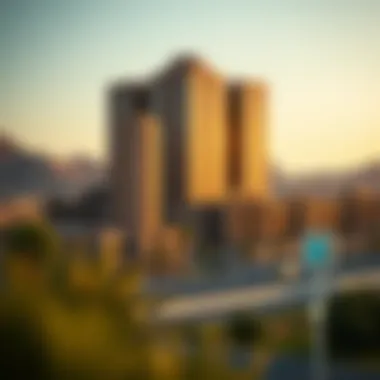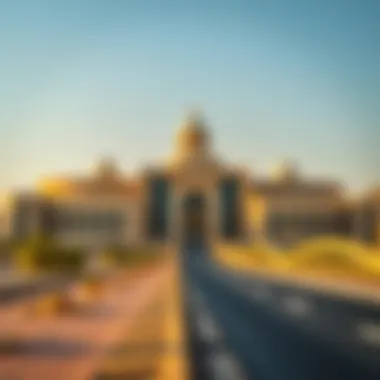Exploring the Transition from Dubai to Al Ain


Intro
The journey from the bustling, flashy streets of Dubai to the more laid-back, historic vibes of Al Ain tells a fascinating story of contrasts and similarities. Both cities offer unique experiences and opportunities, especially for those considering a move or investment in the UAE. Dubai, with its high-rises, luxury lifestyle, and vibrant expat community, often forms the backdrop for business and tourism. Al Ain, renowned as the "Garden City" of the UAE, boasts rich cultural heritage and a more relaxed pace of life, making it an alluring destination for many.
As individuals and families weigh their options between these two cities, understanding the nuances of the transition is crucial. This exploration dives into various dimensions—logistics, community dynamics, and real estate—as potential movers and investors navigate their next steps. Let's unpack the pivotal elements influencing this journey.
Market Trends
In the realm of real estate, understanding market trends is essential for anyone looking to make an informed decision.
Current Market Analysis
As of recent studies, the property market in Dubai continues to reflect robust growth, especially following a temporary slump caused by global events. Prices are gradually stabilizing, but the high demand remains a potent force driving new developments. For instance, areas like Dubai Marina and Downtown Dubai have shown resilience, while new districts such as Dubai Creek Harbour are emerging quickly.
On the other hand, Al Ain's real estate market differs remarkably. The demand for properties here has remained consistent, driven mainly by local residents seeking better living conditions away from the city's hustle and bustle.
- Al Ain’s market is characterized by:
- Lower property costs compared to Dubai
- More family-oriented neighborhoods
- Strong community infrastructure
Future Projections
Looking ahead, both cities display promising indicators for property investments. With about 40% of Dubai's population being expatriates, the city's appeal shows no signs of waning soon. Meanwhile, Al Ain's government is making significant investments in infrastructure and tourist attractions, suggesting a likely uptick in demand.
"Investors should keep a close eye on how Al Ain develops over the next decade. Its growth potential cannot be overlooked as Dubai's expansion continues."
Property Insights
Exploring property options between Dubai and Al Ain requires understanding the varied landscapes and neighborhoods, as well as the types of properties available.
Neighborhood Comparisons
When considering neighborhoods, Al Ain offers quite a different vibe compared to the skyscraper-dense areas of Dubai. In Dubai, neighborhoods cater to diverse demographics:
- Luxury Living: Palm Jumeirah, Dubai Marina
- Family-Friendly: Jumeirah, Arabian Ranches
Contrastingly, Al Ain features neighborhoods that are quieter and more community-oriented, such as Al Muwaiji and Al Ain Oasis. These areas offer efficient amenities but are often more connected to educational and recreational spaces.
Property Types Explained
The types of properties available also vary significantly. In Dubai, one can find:
- Luxury apartments
- Contemporary villas
- Mixed-use developments
Conversely, Al Ain simplifies choices by offering:
- Traditional villas
- Spacious townhouses
- Affordable apartments
Understanding these distinctions is pivotal for anyone contemplating a transition between these two dynamic locations, particularly in terms of lifestyle changes and investment potential.
By grasping these insights about the market trends and property landscapes, prospective movers and investors can better navigate their options in both thriving cities.
The UAE: An Overview
Understanding the United Arab Emirates, particularly the dynamics between Dubai and Al Ain, is essential for anyone looking to make an educated move or investment. The UAE is more than a collection of glitzy skyscrapers; it is a tapestry of cultures and histories that offers unique opportunities and challenges. The diverse characteristics of these cities play a pivotal role in shaping decisions for prospective movers and investors.
Geographical Significance of Dubai and Al Ain
When it comes to geography, Dubai is a major player in the UAE. It stands out as a bustling metropolis that serves as a gateway to global markets. On the flip side, Al Ain presents a contrasting image, often referred to as the Garden City due to its lush landscapes and natural springs. This geographical distinction not only affects the economic prospects but also influences lifestyle choices and community feel.
Benefits of Understanding Geographical Nuances:
- Proximity to Major Markets: Dubai is well-positioned with its international air traffic hub, which is essential for businesses needing quick access to the world.
- Natural Resources in Al Ain: With water sources and agricultural land, Al Ain offers sustainability that is quite different from Dubai’s urban setting.


In evaluating your options, understanding these geographical features is a cornerstone of making informed decisions, whether you seek investment opportunities or lifestyle changes.
Historical Context of the Two Cities
Every city has a backstory that forms its identity, and Dubai and Al Ain are no exception. Dubai has undergone a transformation from a humble fishing village to a global financial center in a relatively short period. In contrast, Al Ain carries a rich history that dates back to ancient times, with archaeological findings indicating human settlement as far back as 3000 BCE.
Historical Significance:
- Dubai's Development: The discovery of oil in the 20th century acted as a catalyst for rapid infrastructure growth, transforming its landscape and economy.
- Al Ain's Heritage Sites: Known for its significant archaeological sites like Hili and the Al Jahili Fort, Al Ain emphasizes its cultural identity and heritage.
These historical narratives contribute significantly to the character and appeal of each city, enriching the experiences of those who move or invest there. By grasping the historical context, you not only understand the present but also anticipate future developments and opportunities for both cities.
In summary, the UAE's geographical and historical uniqueness plays a crucial role in shaping the lifestyles and opportunities available in Dubai and Al Ain, making it imperative for potential movers and investors to delve into these aspects for a well-rounded decision-making process.
Understanding Dubai
Dubai stands as a beacon of opportunity and innovation within the United Arab Emirates. Its rapid growth from a modest fishing village to a global city is nothing short of remarkable. For anyone looking to transition to Al Ain or dive deeper into the Emirati landscape, understanding Dubai is crucial. This section serves as a cornerstone for analyzing the lifestyle, economic opportunities, and cultural nuances that define both cities.
Economic Landscape of Dubai
Dubai's economic landscape is dynamic and diversified, distinguishing it from many other cities in the region. The emirate thrives on several key sectors:
- Tourism: An essential pillar, attracting millions yearly with landmarks such as the Burj Khalifa and Palm Jumeirah.
- Trade and Logistics: Positioned strategically, Dubai functions as a trade hub connecting East and West, courtesy of its advanced port facilities and logistics network.
- Real Estate: Home to some of the most luxurious residences and commercial spaces, the property market here offers a plethora of options for investors.
- Technology and Innovation: Initiatives like Dubai Internet City showcase a significant push toward a knowledge-based economy.
What makes Dubai's economy particularly appealing is its unwavering dedication to fostering a business-friendly environment. Economic free zones with 100% ownership, coupled with minimal trade barriers, invite both local and international investors. This enticing backdrop encourages not just survival but flourishing in various sectors. However, investors must stay attuned to market trends as they can fluctuate rapidly due to global economic shifts.
Cultural and Social Dynamics
The cultural and social dynamics of Dubai are a complex tapestry woven with Emirati traditions and a myriad of expatriate influences. The city presents a unique blend of old and new:
- Heritage: Despite its modern façade, Dubai is deeply rooted in Arabic culture. Traditional markets, or souks, offer visitors a taste of history amid contemporary architecture.
- Diverse Population: With a substantial expatriate community, the social fabric thrives on cultural exchanges, fostering a cosmopolitan atmosphere.
- Festivals and Events: Annual festivities such as the Dubai Shopping Festival and Ramadan contribute to the vibrant social calendar, allowing for an immersive experience into local customs.
Understanding these dynamics is essential for anyone contemplating life in Al Ain. While Dubai embodies a lively, fast-paced environment, Al Ain tends to reflect a more traditional lifestyle, showcasing its rich history and slower rhythm.
Real Estate Market Overview
As one of the most prominent and bustling real estate markets in the world, Dubai offers an almost endless variety of commercial and residential options. The real estate market can be characterized by its:
- Luxury Developments: Properties like the Burj Al Arab and expansive villas in Emirates Hills cater to high-net-worth individuals.
- Investment Opportunities: Given the significant return on investment potential, many investors look to Dubai not just for residency but as a lucrative hub for property ventures.
- Trends: The ongoing developments in areas like Dubai Marina and Downtown continue to attract substantial interest, although market trends can shift, calling for vigilance from prospective buyers.
"Dubai’s real estate sector has shown resilience and adaptability, buttressed by a young population and a growing economic landscape."
For those interested in the Al Ain market, a deep knowledge of Dubai’s real estate characteristics can provide valuable insights, particularly in understanding regional price influences and investment potential.
Delving into Dubai's socio-economic features provides a clearer lens for viewing Al Ain. While both cities boast unique attributes, being knowledgeable about Dubai's resources, lifestyle, and market conditions can significantly impact one’s transition and integration into the more tranquil life found in Al Ain.
Al Ain: A Different Narrative
Al Ain, often overshadowed by the glitz of Dubai, presents a unique narrative worthy of exploration. Known as the "Garden City" for its lush greenery, it offers a blend of natural beauty and rich heritage. This section delves into how Al Ain sets itself apart from its bustling counterpart, listing key elements that make it an attractive choice for movers and investors alike.
Economic Factors Influencing Al Ain
Al Ain's economy is rooted in agriculture, tourism, and a growing emphasis on sustainability. Its agricultural roots date back centuries, with dates and citrus fruits being prominent crops. This contrast to Dubai’s high-octane real estate and tourism-centric economy often translates to a more steady and sustainable growth pattern for Al Ain.
- Agriculture: The city benefits from an oasis environment, allowing for a unique agricultural base. The local produce market flourishes, attracting residents with its freshness.
- Tourism: Al Ain is home to several UNESCO World Heritage sites, including the ancient Hili archaeological sites and the Al Ain Oasis. These sites draw in both tourists and researchers, boosting local businesses and the economy.
- Investment in Infrastructure: As Al Ain expands, smart infrastructure projects are emerging, improving connectivity and enhancing the living experience.
In summary, economic diversification, a strong agricultural base, and an influx of tourism make Al Ain a viable option for those looking to invest.
Cultural Richness and Heritage
Al Ain's cultural richness is deeply ingrained in its historical roots. It is a city where traditions and modernity coexist harmoniously. Here, your experience is peppered with Bedouin heritage, evident in the local souks, museums, and cultural centers.
- Heritage Sites: The Al Ain National Museum and Qasr Al Muwaiji stand out as beacons of the region’s rich history, providing insights into the emirate's origins.
- Festivals: Cultural festivals, such as the Al Ain Camel Festival and the Al Ain Book Fair, reflect the community's vibrant traditions and draw significant crowds, showcasing local talents and products.
- Community Life: The people of Al Ain are known for their hospitality. The focus on cultural preservation creates strong community ties, differing from the more transient lifestyle seen in Dubai. This aspect is particularly appealing to families and individuals seeking a tight-knit community.


The cultural depth and heritage of Al Ain not only attract tourists but also create a respite for those looking to immerse themselves in a vibrant and historically rich environment.
Real Estate Insights in Al Ain
The real estate market in Al Ain presents a different avenue compared to the high-paced energies of Dubai. With a variety of options available, prospective buyers and investors will benefit by understanding the current trends and dynamics at play.
- Affordability: Compared to Dubai, property prices in Al Ain remain more palatable. This affordability trend makes it an appealing choice for first-time home buyers and families looking for space without breaking the bank.
- Property Types: From spacious villas in serene communities to contemporary apartments, Al Ain offers diverse options that cater to various lifestyle preferences. This broad spectrum allows individuals to find a niche that fits their needs and budgets.
- Growth Potential: With increasing interest in the area, fueled by infrastructure developments and economic diversification, Al Ain’s real estate market shows promise for future appreciation. Investors have a chance to enter at a favorable price point before the next wave of development takes off.
In essence, Al Ain's real estate landscape provides a compelling blend of affordability, variety, and potential for future growth, making it a noteworthy player in the UAE's property market.
The Journey: Dubai to Al Ain
The journey from Dubai to Al Ain represents not only a physical transition but also a significant cultural and lifestyle shift within the UAE. Understanding this journey is crucial for anyone considering relocation or commuting between these two cities. The stark contrast in urban development, pace of life, and cultural heritage provides essential insights into what one can expect when navigating this route.
This section will delve into various transportation options available, time considerations for making the trip, and navigating traffic patterns on the way. Each element plays a pivotal role in shaping the experience of travel between these two destinations.
Transportation Options Available
Road Travel: Cars and Buses
Road travel remains the most common and practical way to move from Dubai to Al Ain. Private cars and buses offer a range of advantages that cater to different needs. For many, owning or renting a vehicle provides flexibility in travel times and the luxury of a personalized experience.
Key Characteristics: Cars afford privacy, comfort, and control over the journey, enabling one to stop at roadside attractions or take scenic routes. Buses, on the other hand, are economical and equipped with air conditioning, critical for the harsh desert climate.
Unique Feature: The well-maintained highways-andurban roads connecting the two cities are designed for efficiency. Notably, the Dubai-Al Ain Road is a dual carriageway that sees substantial travel, linking key points of interest along the route.
Advantages: The choice of road travel is beneficial due to its ease of access and relatively low cost, especially for families or groups.
Disadvantages: However, potential drawbacks include the inevitability of traffic congestion, particularly during weekends or holidays.
Rail Connections and Future Prospects
Although rail travel between Dubai and Al Ain is still in the embryonic stage, future prospects are on the horizon. The UAE recognizes the increasing need for sustainable transportation methods, which has prompted interest in developing a railway network linking major cities.
Key Characteristics: A proposed rail service would significantly cut travel time and offer an alternative to road congestion, providing efficient connections between urban and rural areas.
Unique Feature: The railway system would aim for modernity and speed, potentially featuring high-speed trains that could revolutionize intercity travel in the UAE.
Advantages: If realized, this connection would enhance the ability for daily commuters and tourists alike to traverse the landscape with ease, reducing dependence on road travel.
Disadvantages: However, development is still contingent on funding, political considerations, and logistical challenges. There might be delays, thus making road travel the more practical choice in the interim.
Time Considerations for Travel
Travel time between Dubai and Al Ain varies based on the chosen mode of transport and prevailing traffic conditions. By car, the journey generally takes around 1.5 to 2 hours, assuming smooth traffic, while buses may take slightly longer due to scheduled stops. During peak hours or weekends, this time can extend, emphasizing the importance of planning ahead.
Navigating Traffic Patterns
Traffic patterns can be a tricky aspect of travel in the UAE, influenced by the time of day and even the day of the week. Weekdays often see heavier traffic in and out of Dubai, as many commuters travel for work. Conversely, weekends might witness increased traffic as families travel for leisure to Al Ain, known for its parks and resorts.
To mitigate delays, familiarity with alternative routes or real-time traffic updates through apps like Google Maps can make a significant difference. By staying informed about expected traffic conditions, travelers can better optimize their journeys.
Lifestyle Differences Between Dubai and Al Ain
Understanding the lifestyle differences between Dubai and Al Ain is crucial for anyone considering a move or investment in the UAE. While both cities are part of the same country, they offer distinct experiences shaped by their demographics, economic opportunities, and cultural environment.
Dubai is often viewed as the cosmopolitan hub of the UAE, where skyscrapers dominate the skyline and international business thrives. It is a place that never seems to sleep; there’s always something happening, and the energy is palpable. In contrast, Al Ain presents a more tranquil atmosphere, known for its rich heritage and historical significance. This city, often referred to as the "Garden City," features lush greenery and a slower pace of life compared to the bustle of Dubai. Let’s delve deeper into key elements that contrast the lifestyles of these two cities.
Cost of Living Comparisons
The cost of living is a significant consideration for many people looking to relocate. In Dubai, living expenses can eat up quite a chunk of one’s income, thanks to its upscale lifestyle and amenities. Factors like housing, dining, and entertainment contribute to a higher cost. For instance, a typical one-bedroom apartment in the city center can often rent for over AED 8,000 a month, making it one of the pricier places to live in the region. On the other hand, Al Ain is more affordable. You might find a comparable one-bedroom apartment at around AED 4,500. This considerable difference in rental prices can factor heavily into a buyer's or renter's decision for a new home.
In addition, everyday expenditures like groceries and transportation are typically lower in Al Ain. For those seeking a lifestyle that affords more financial flexibility, Al Ain may be more appealing.


Healthcare Facilities and Accessibility
Healthcare is a top priority for people considering relocation. Dubai boasts world-class medical facilities equipped with advanced technology and a wide range of specialized services. The city is home to renowned hospitals like Dubai Hospital and the American Hospital Dubai, ensuring that residents have access to quality care.
Conversely, Al Ain has made significant strides in healthcare, with facilities like Al Ain Hospital providing solid medical services. However, the range of specialized treatments may not be as extensive as in Dubai. That said, the healthcare costs in Al Ain tend to be lower, meaning residents might benefit from saving while still receiving essential medical care. Accessibility is also commendable; while the city isn’t as frenetic as Dubai, it still offers reliable public transport options for getting to clinics and hospitals.
Education and Schooling Options
For families, the education system is a cornerstone of community life. Dubai is well known for its plethora of international schools and high-quality educational institutions offering diverse curricula that cater to expatriates. Institutions such as the International School of Arts and Sciences or the Dubai American Academy exemplify this commitment to quality education. However, tuition fees can be high, often costing upwards of AED 30,000 per year.
In comparison, Al Ain offers fewer international schools, but there are solid public educational institutions available, alongside private schools that provide a good standard of education at a lower cost. Families might find that educational opportunities align better with their budgets in Al Ain, especially for those who prioritize basic education without the frills.
In summary, the lifestyle differences between Dubai and Al Ain center on a multitude of factors, including cost of living, healthcare, and education. Making an informed decision requires not just financial considerations, but also an understanding of what daily life will feel like in each city. In the end, whether one thrives in the heart of bustling Dubai or in the serene embrace of Al Ain hinges on personal preferences and priorities in lifestyle.
Real Estate Considerations for Moving
When contemplating a move from the bustling city of Dubai to the more serene Al Ain, it's vital to delve into the real estate landscape. This transition isn't just about swapping one home for another; it’s about embracing a different lifestyle and financial investment that requires thorough understanding.
Comparative Market Trends
Understanding the market trends in both cities can feel like navigating a maze without a map. In Dubai, the real estate market is known for its rapid pace, often reflecting the city’s dynamic lifestyle. The prices tend to fluctuate based on luxury demand and foreign investments, which means that buyers might need to keep their eyes peeled for the best deals. Properties in areas like Dubai Marina or downtown often see premium pricing, whereas areas in the outskirts can be more budget-friendly.
Conversely, when we look at Al Ain, the scene significantly contrasts. The real estate market here is generally slower, which can benefit buyers looking for stability. Prices remain more affordable, reflecting a population that values both community living and traditional culture. Notably, property values in Al Ain show steady, but slower increase compared to Dubai, making it an appealing option for those cautious about market volatility.
Consider this:
- Dubai: High demand, fluctuating prices, luxury appeal.
- Al Ain: Stable prices, community-focused, slower market growth.
Investment Potential in Both Cities
Real estate investment is a venture that can yield significant returns, but one must weigh the potential against the risks. In Dubai, the investment opportunities are vast, encompassing luxury villas, modern apartments, and commercial properties. With projects like the Dubai Expo 2020 and a continual influx of tourists, the city remains a hotbed for investments. Investors often find that properties in Dubai can command high rental yields, as many expatriates seek short-term leases.
On the flip side, Al Ain holds its own potential. The city's expansion plans and rising interest in sustainable living create a unique milieu for long-term investment. Properties here tend to appreciate at a steadier rate, often providing a solid return against the backdrop of lower initial costs. For those considering family homes or long-term rentals, Al Ain proves to be a wise choice.
Neighborhood Dynamics and Community Feel
When moving, understanding the neighborhood dynamics and community feel can make all the difference. Dubai neighborhoods radiate a cosmopolitan vibe, with every corner bursting with diversity. Areas like Jumeirah or Downtown are alive with activity and social gatherings, appealing to those who thrive in a vibrant environment.
In Al Ain, the atmosphere shifts to a more cozy and intimate setting. Here, one can often walk down the street and know their neighbors, fostering a strong sense of community. Families tend to be more prevalent, and social activities often revolve around cultural events and outdoor gatherings. The pace of life is more relaxed, appealing to those who prefer tranquility over the fast lane.
Finale: Making an Informed Transition
Transitioning from one locale to another is rarely as straightforward as packing your bags and hitting the road. The move from Dubai to Al Ain requires careful consideration of a variety of factors—cultural, economic, and social. The importance of this concluding section lies not just in summarizing significant points discussed throughout the article; it serves as a strategic guide to help prospective movers make educated decisions laden with potential benefits.
It’s essential to weigh in on the transition's nuances. Each city's distinct lifestyle can enrich or challenge your adaptation process. In Dubai, the pulse is fast. On the flip side, Al Ain offers a laid-back atmosphere, characterized by a more community-focused lifestyle. Encountering these shifts, you will need to consider how they resonate with your personal expectations and goals.
“Change might feel daunting, but it's also an opportunity for growth.”
Planning is paramount. Having a solid grasp of the market dynamics and local customs in both cities equips movers with a toolkit to navigate this transition effectively. Homebuyers should channel insights gained from this article into their decision-making about property investments. Take stock of local trends as well. This knowledge acts as your compass, leading you to secure the best deal available.
Alongside practical considerations, let’s not disregard the emotional facets involved. Understanding how the communities in each city function, their way of life, and prevailing attitudes can significantly influence your integration into a new setting.
The ultimate goal here is to empower you to step into this new chapter with confidence, armed with a thorough understanding of what to expect and how to adapt effectively—smoothing the passage from the thriving urbanity of Dubai to the serene charm of Al Ain.
Summary of Key Insights
Throughout the article, we have stressed various key points crucial to the transition from Dubai to Al Ain, including:
- Cultural Divergence: Recognizing how social habits differ between the two cities can help in adjusting mindset and behaviors.
- Lifestyle Dynamics: The shift in pace from Dubai to Al Ain means understanding and possibly embracing a less frantic daily life.
- Real Estate Nuances: With varying property prices and types, investors should delve into market trends to make informed choices.
- Transportation Availability: Understanding options for transport ensures smooth transitions between these urban centers.
Each of these insights fortifies the foundation of your journey, giving you a clearer picture of the landscape you'll be entering.
Recommendations for Prospective Movers
For those contemplating the move, consider the following recommendations that can make your transition easier:
- Research Thoroughly: Delve into community blogs or forums like reddit.com that can offer firsthand experiences of residents in both cities.
- Visit Before Moving: If possible, spend some time in Al Ain. Understanding the local atmosphere can help ease your adjustment.
- Engage with Locals: Building connections with residents can provide useful insights and a support network as you settle. Use social media platforms like Facebook to find groups related to expats in Al Ain.
- Explore Educational Opportunities: If you have children, investigate schooling options well in advance, as they can greatly affect your overall experience.
- Stay Updated on Real Estate: Keep an eye on property listings to catch the best deals in Al Ain. Websites can guide you through the trends over time.
Adapting to life in another city always comes with its challenges, but it also unveils new horizons. Through knowledge and preparation, the move from Dubai to Al Ain can turn into a fulfilling chapter in your life.















